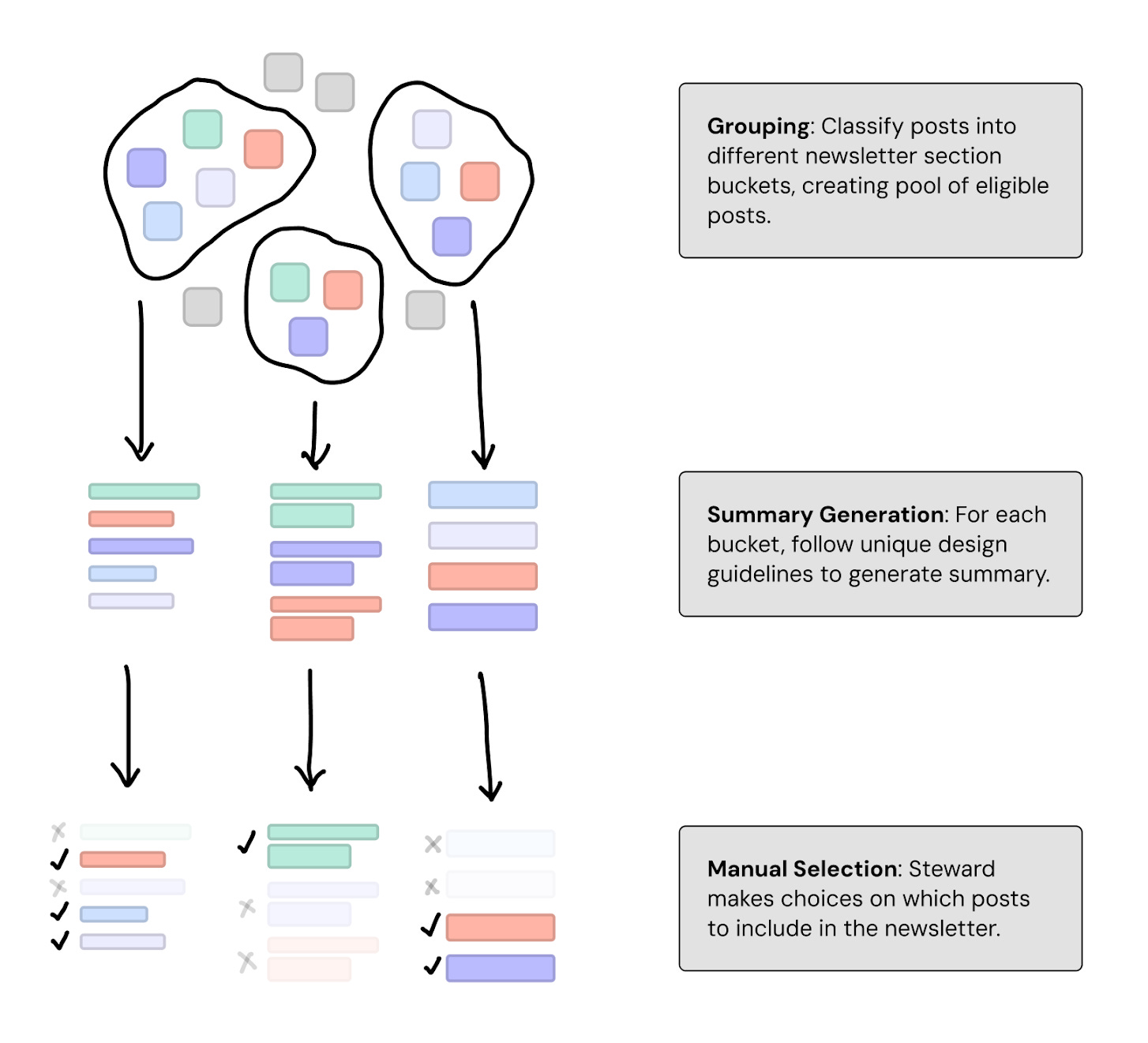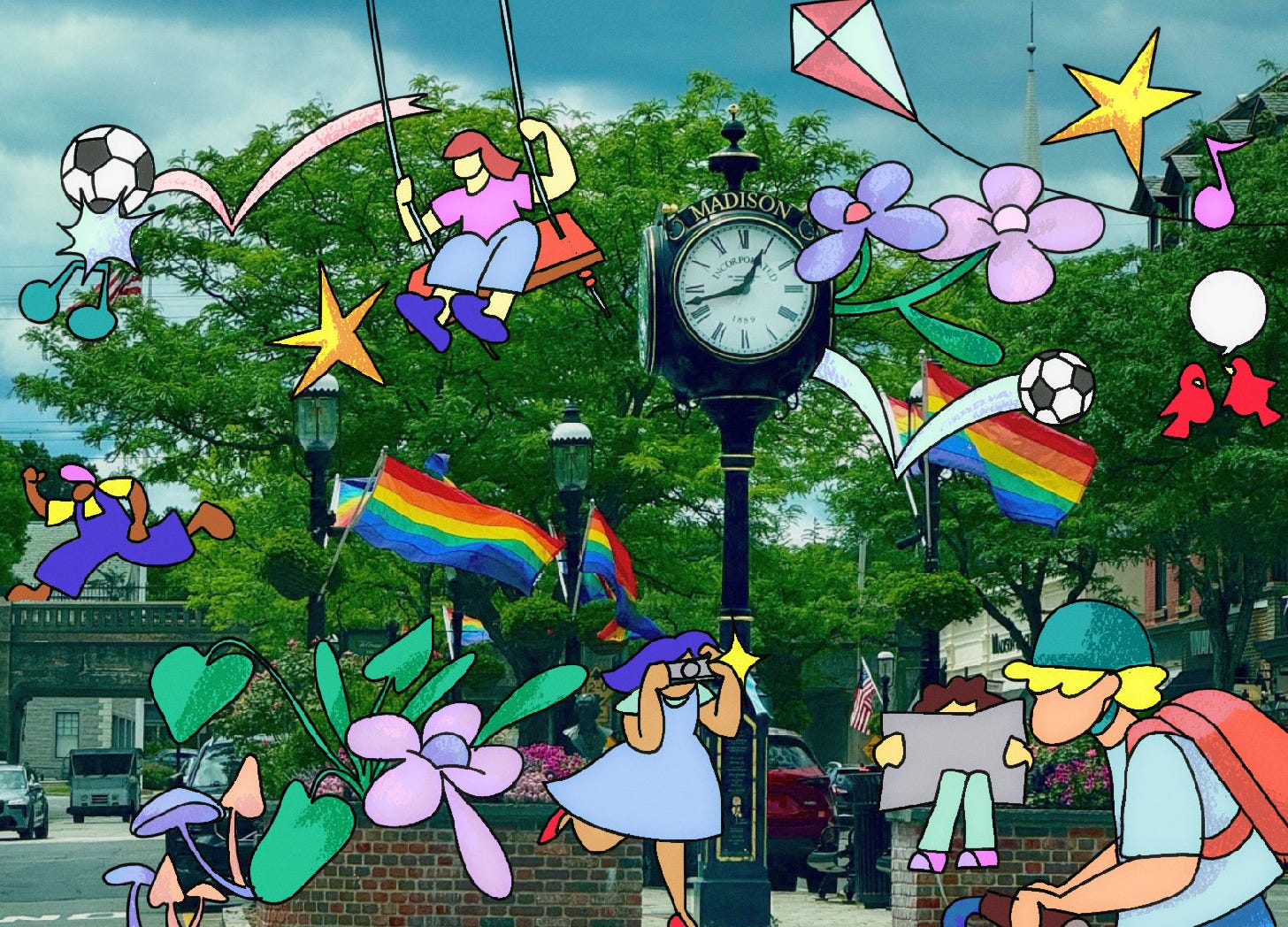📬 Reviving the community newsletter for the digital age
Piloting away from endless feeds and towards curated digests
We are seeking a Project Manager to join our Local team.
ARD (Germany) and ABC (Australia) are joining Public Spaces Incubator! The collaborative project has been extended through 2027. More here.
In working to improve local digital spaces like place-based Facebook groups and Nextdoor neighborhoods, we have been focusing our efforts along two parallel tracks, which sometimes intertwine. First, we want to support the work of community stewards. Along those lines, we recently introduced our stewards of these spaces.
Below, Adit Dhanushkodi from New_ Public’s Local Lab, with help from recent Fellow Leila Kashani-Sabet, shares an experiment on the other track: boosting social trust and belonging in these communities. As you’ll see below, this pilot involves surfacing community posts into a distinctly old school format — a round-up summary newsletter of what’s happening near you. It’s the best kind of sociotechnical effort: technology empowering human expertise and leadership in service of genuine public-spirited connection.
Also, Local Lab’s leader, Angelica Quicksey, recently made this deck, surveying everything we’ve learned about local digital spaces over the last half year. For a deep dive into our research and analysis, please give it a read.
– Josh Kramer, New_ Public Head of Editorial
The humble community newsletter, once a photocopied paper shoved in mailboxes and now more often an email, is an under-appreciated tool in bringing together a local town or neighborhood. It serves the practical purpose of keeping everyone informed about local happenings, but over time, a local newsletter can also help to establish a shared identity and narrative. For people new to the area, it can be a vital resource for understanding their neighbors and making connections with them. For longtime residents of a neighborhood, a newsletter can become a way to see themselves represented. Sometimes they become trusted sources of local information, curated by a passionate individual or local organizations.
Nowadays, local digital spaces have become more common for finding and sharing information. In comparison to the community newsletter, the digital group creates space for conversation between neighbors. It’s a multi-directional exchange rather than a one-way transmission from the newsletter’s writer. Instead of clearly curated sections of content, the digital group is often experienced as an endless and sometimes overwhelming feed of information.
These feeds are full of all kinds of information, from asks for the best local restaurants to heated discussions about the latest town referendum, and are mainly being curated by personalized algorithms optimized for engagement, like those on Facebook and Nextdoor. On Facebook in particular, this dynamic is exacerbated because many people interact with groups primarily through their main Facebook Feed, where the local group’s posts are mixed with posts from other groups and friends.
The posts that community members see are largely based on their own interests and behavior. Some people might mostly see big, nasty conflicts, while others are only seeing pet adoption posts. Time spent on the platform can also vary wildly — some people constantly scroll through the group while others check in once a week. This fragmentation in experience results in each of us seeing our digital community, and therefore our physical community, a little bit differently. We no longer have a shared understanding of our spaces.
Is it possible to have the best of both worlds? What would it look like to bring the ethos of the community newsletter to our current age of digital local groups? What if the steward of your community could easily curate a weekly summary that both helped you keep up with what was going on, but also helped build a shared community narrative?
Piloting Summary Newsletters
Over two months, we partnered with two stewards of local Facebook groups to prototype community newsletters based on content from their groups. Together we identified the most important topics to include, co-designed the look and feel of the newsletter, and posted the newsletters in the digital spaces weekly. Afterwards, we evaluated their impact. Each of the stewards we worked with were trying their best to establish their visions for their communities, while overcoming the limitations of the algorithmic feed and the lack of platform tools to support them.
Our first collaborator established their Facebook group in response to the difficulty of finding useful local information. Their goal was to create an essential resource for local information, making news, recommendations, advice, and events in town as accessible and clear as possible to residents. In this community, we heard about how the structure of the Facebook feed made it difficult to learn about and remember the community events that were shared. A well-designed newsletter could serve as a way to better organize information, making it more accessible to members.

Our second collaborator came from a group that was facing toxic and negative posts a few years ago. Over time, the stewards developed new rules and moderation practices to clarify what is and isn’t allowed, resulting in a more healthy space. Given this history, many community members still remain hesitant to participate, so the steward has been especially focused on cultivating a positive and welcoming culture. They explained,
One of the things I'd like to see on the page is just people talking to each other the way they would talk over the fence in the backyard, because that's essentially what this has become! We don't talk to our neighbors anymore, we don't see them out on the front porch. I kind of like to think of this as the front porch in the way to get to know people in your town and also get helpful advice.
Because stewards don’t have any control over what is emphasized by the feed, neighbors may miss positive, wholesome posts, like one about a kid’s lemonade stand or another exchange that resulted in soccer balls being donated to the local community center. With a summary newsletter, this steward would be able to highlight these posts and surface more community positivity and camaraderie.
Once we established a design, we went through a four week experiment creating newsletters and releasing them in both communities. We used this experiment as an opportunity to evaluate the potential for AI large language models to help create newsletters like this in the future. LLMs like ChatGPT appear to be well-suited to creating summaries, and creating newsletters using these tools helped us evaluate the technology’s strengths, limitations, and risks for this particular use case, which we’ll share more about later.
Through this pilot project, New_ Public ultimately wanted to understand if summary newsletters could play a role in bringing our stewards’ visions to light, and help them build stronger community narratives. We tested the effectiveness of the newsletters with a variety of methods, including using Google Analytics to see how many readers we were getting, reviewing Facebook analytics to see how many members each summary newsletter reached, interviewing community members, and posting surveys to Facebook.

Takeaways from creating eight newsletters
The number of readers varied from newsletter to newsletter. As expected, there was an initial higher level of interest, with 200-400 people opening the first newsletter, and a drop-off afterwards. We delivered these newsletters via the feed rather than email so that we could test without needing to collect email addresses, but this made it difficult to interpret the readership metrics. We heard from members that while they enjoyed reading the first one, they had no idea whether or not they would see future newsletters being posted, and one member shared in a survey that they only ever saw one newsletter.
Furthermore, the people who would most benefit from a weekly summary — community members who participate the least — are also the least likely to encounter it in the first place, given they aren’t visiting the group as often. These dynamics further highlight the challenges stewards have with shaping their community on the biggest, most popular platforms. Any new practices they take, norms they implement, or tools they use are ultimately filtered through an opaque algorithmic feed that makes it hard to know how much impact their intervention has or how they might improve it.
Despite delivery challenges, it was clear that these summaries solved real problems with organizing information for both members and stewards. Both of our steward collaborators primarily relied on their intuition to understand their community’s behavior, and they greatly appreciated seeing all the posts from their community summarized and organized into clear lists and tables. Members also found that the newsletter format helped them see different types of posts more clearly: one member was surprised to see that their community had a large number of pet adoption posts, while other members were happy to see posts highlighted that they otherwise would have missed.
Finally, the process of putting together these newsletters highlighted a tension: members got significant value from smaller, practical exchanges like asking for recommendations and advice — most posts had fewer than ten comments, with an average of three comments per post. The academic research shows that these kinds of repeated, small exchanges between members is what helps build social cohesion. At the same time, stewards and long-time members both expressed frustration at the same common questions being asked over and over again in the community. Based on this observation, we’ve been considering how we might design for neighborly exchange in a way that preserves those key moments of interaction, but at the same time doesn’t burn out the community with repeated questions.
As we move forward, these learnings, especially those about the limitations of the algorithmic feed, are shaping the next set of pilot experiments we plan to explore. We remain excited about the idea of a community newsletter for local digital spaces and want to keep iterating on the possibilities, especially around other approaches to distribution beyond the feed.
–Adit Dhanushkodi and Leila Kashani-Sabet
Thanks Adit and Leila!
Also, our Communications Fellow, Haoshu Deng, is moving on. She produced a lot of great work for New_ Public, including the art at the top of this newsletter. Thank you Haoshu!
Picking out Halloween candy,
—Josh





It's refreshing to see tech development with a genuinely human-centered approach. I vibe strongly with the power of a newsletter. At our Village micro-communities (villageco.org), email bulletins composed of contributions by members of the community form the center of our asynchronous communication tools.
Our software is based on Airtable and will one day need a major overhaul. I'd sure love to talk to someone about this future project... someone who understand that the goal is not to aggregate the contributions of Villages together. Rather, the need is to help small communities organize what they want to share and not over-complicate it.